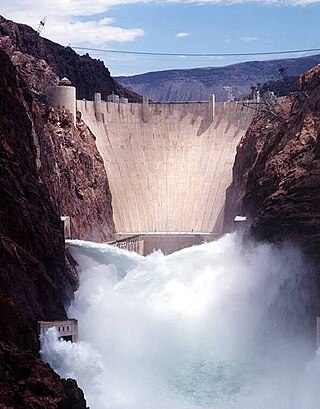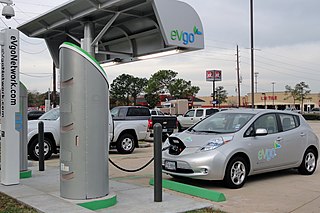Related Research Articles

Falls County is a county in the U.S. state of Texas. As of the 2020 census, its population was 16,968. The county seat is Marlin. It is named for the original 10-foot-tall waterfall on the Brazos River, which existed until the river changed course during a storm in 1866. The present falls is two miles northeast of the original falls, at the Falls on the Brazos Park, a camping site only a few miles out of Marlin on Farm to Market Road 712.

Duke Energy Corporation is an American electric power and natural gas holding company headquartered in Charlotte, North Carolina.
DTE Electric Company was founded in 1886.

The Texas Interconnection is an alternating current (AC) power grid – a wide area synchronous grid – that covers most of the state of Texas. The grid is managed by the Electric Reliability Council of Texas (ERCOT).

The Texas Commission on Environmental Quality (TCEQ) is the environmental agency for the state of Texas. The commission's headquarters are located at 12100 Park 35 Circle in Austin. The fourth-largest environmental agency in the United States, it employs about 2,780 employees, has 16 regional offices, and has a $420 million operating budget for the 2016 fiscal year.

The Edison Electric Institute (EEI) is an association that represents all U.S. investor-owned electric companies.
Griddy was an American power retailer that formerly sold energy to people in the state of Texas at wholesale prices for a $10 monthly membership fee and had approximately 29,000 members. The company itself was based in California.
Comanche Electric Cooperative, Inc. is a non-profit rural electric utility cooperative headquartered in Comanche, Texas, United States of America.

Brazos Belle was a 160-foot (49 m) American riverboat constructed for use on the Brazos River in Texas. Permanently docked in Waco, Texas as a restaurant in 1997, the Belle often hosted dinner parties, receptions, and functions for local Greek organizations. Flooding in 2007 badly damaged the boat; although the Belle was refloated, repairs proved uneconomical, and the Brazos Belle was scrapped late in 2008.

New York energy law is the statutory, regulatory, and common law of the state of New York concerning the policy, conservation, taxation, and utilities involved in energy. Secondary sources have also influenced the law of energy in the Empire State.

Luminant is a Texas-based electric utility. It is a wholly owned subsidiary of Energy Future Holdings Corporation. Luminant's operations include electricity generation and wholesaling, mining, construction, and development. The company has capacity for the generation of 18,300 megawatts (MW) of electricity in 20 power plants spread across Texas, of which 2,300 MW come from nuclear power generated at the company's Comanche Peak Nuclear Power Plant, 5,800 MW from coal-fired power plants, and the remainder from natural gas-fired plants. Luminant is also a major purchaser of wind power.
There is a large array of stakeholders that provide services through electricity generation, transmission, distribution and marketing for industrial, commercial, public and residential customers in the United States. It also includes many public institutions that regulate the sector. In 1996, there were 3,195 electric utilities in the United States, of which fewer than 1,000 were engaged in power generation. This leaves a large number of mostly smaller utilities engaged only in power distribution. There were also 65 power marketers. Of all utilities, 2,020 were publicly owned, 932 were rural electric cooperatives, and 243 were investor-owned utilities. The electricity transmission network is controlled by Independent System Operators or Regional Transmission Organizations, which are not-for-profit organizations that are obliged to provide indiscriminate access to various suppliers to promote competition.

Hydropower policy in the United States includes all the laws, rules, regulations, programs and agencies that govern the national hydroelectric industry. Federal policy concerning waterpower developed over considerable time before the advent of electricity, and at times, has changed considerably, as water uses, available scientific technologies and considerations developed to the present day; over this period the priority of different, pre-existing and competing uses for water, flowing water and its energy, as well as for the water itself and competing available sources of energy have changed. Increased population and commercial demands spurred this developmental growth and many of the changes since, and these affect the technology's use today.

Energy in California is a major area of the economy of California. California is the state with the largest population and the largest economy in the United States. It is second in energy consumption after Texas. As of 2018, per capita consumption was the fourth-lowest in the United States partially because of the mild climate and energy efficiency programs.

The Electric Bond and Share Company (Ebasco) was a United States electric utility holding company organized by General Electric. It was forced to divest its holding companies and reorganize due to the passage of the Public Utility Holding Company Act of 1935. Following the passage of the Act, the U.S. Securities and Exchange Commission (SEC) selected the largest of the U.S. holding companies, Ebasco to be the test case of the law before the U.S. Supreme Court. The court case known as Securities and Exchange Commission v. Electric Bond and Share company was settled in favor of the SEC on March 28, 1938. It took twenty-five years of legal action by the SEC to break up Ebasco and the other major U.S. electric holding companies until they conformed with the 1935 act. It was allowed to retain control of its foreign electric power holding company known as the American & Foreign Power Company (A&FP). After its reorganization, it became an investment company, but soon turned into a major designer and engineer of both fossil fuel and nuclear power electric generation facilities. Its involvement in the 1983 financial collapse of the Washington Public Power Supply System's five nuclear reactors led to Ebasco's demise because of the suspension of nuclear power orders and lawsuits that included numerous asbestos claims. The U.S. nuclear industry stopped all construction of new facilities following the 1979 nuclear meltdown at Three Mile Island, going into decline because of radiation safety concerns and major construction cost overruns.

The Comanche Solar Project is a 120 megawatt (MWAC) photovoltaic power station near the city of Pueblo, Colorado. It became the largest solar facility in the state when it came online in late 2016. The electricity is being sold to Public Service of Colorado, a subsidiary of Xcel Energy, under a 25-year power purchase agreement (PPA). Xcel determined through an open bid process that the PPA's terms were competitive with natural gas.

As of 18 April 2023, there were 185,511 electric vehicles registered in Texas.
References
- 1 2 Diaz, Jaclyn (2021-03-01). "Texas Energy Co-Op Files For Bankruptcy After Storm, High Bill". NPR. Retrieved 2021-03-01.
- ↑ writer, MIKE COPELAND, Tribune-Herald staff (7 July 2013). "Mike Copeland: Fuzzy Taco bound for Waco". WacoTrib.com. Retrieved 2020-07-29.
{{cite web}}: CS1 maint: multiple names: authors list (link) - ↑ Garber, Jennifer (January 30, 2020). "Duke Energy Renewables' largest Texas solar project now online". www.bloomberg.com. PR Newswire. Retrieved 2020-07-20.
- ↑ Downey, John (January 30, 2020). "Duke Energy's latest solar project is its biggest in Texas — but not for long". www.bizjournals.com. Retrieved 2020-07-20.
- ↑ Carver, John A (May 1969). "Legislating for Electric Power Reliability" (PDF). University of Denver. Archived (PDF) from the original on 2015-10-28. Retrieved July 28, 2020.
- 1 2 Hearings, reports and prints of the Senate Committee on Commerce. 1967.
- ↑ "TJB | SC | Orders & Opinions | 2019 | May | May 3, 2019". www.txcourts.gov. Retrieved 2020-07-29.
- 1 2 "Ad Valorem Tax Exemption/Pollution Control Property: Supreme Court of Texas Addresses Challenge to Texas Commission on Environmental Quality Interpretation". JD Supra. May 30, 2019. Archived from the original on 2020-07-29. Retrieved 2020-07-29.
- ↑ "Brazos Electric Power Cooperative, Inc. v. Texas Commission on Environmental Quality". Justia Law. January 24, 2019. Archived from the original on 2020-07-29. Retrieved 2020-07-29.
- ↑ Baer, Tonya (June 26, 2020). "Texas Commission on Environmental Quality Interoffice Memorandum" (PDF). Texas.gov. Archived (PDF) from the original on 2020-07-29. Retrieved July 28, 2020.